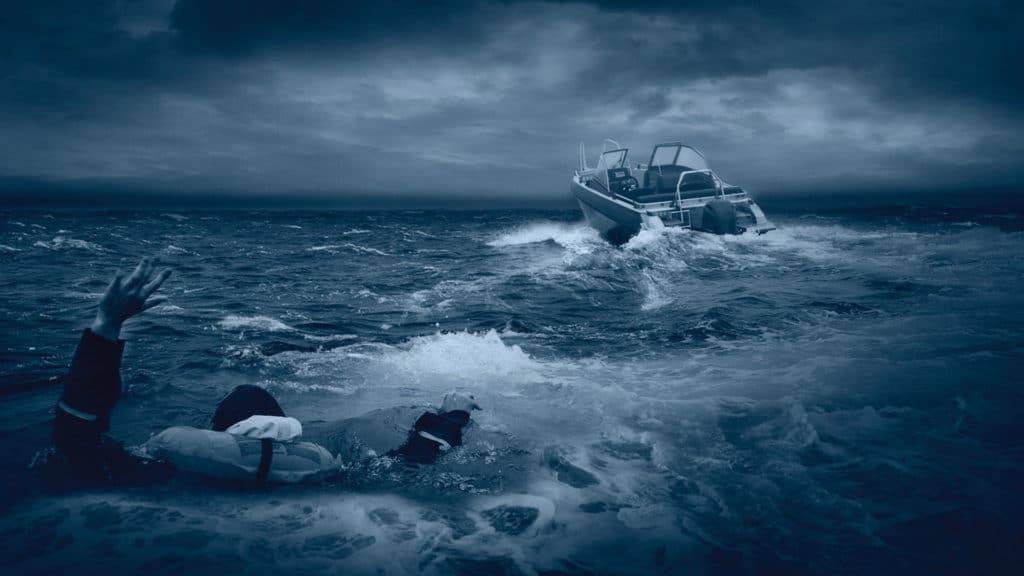
Venturing out on the ocean by myself provides welcome respite from the whir of urban life. I find peace amid the salt air, coastal currents and creatures of the sea.
Yet in such complacency lies danger. A sudden slip, the wake of a nearby vessel or extending to gaff a fish can send you overboard with no crew to muster a rescue. If the boat’s in gear, you’re toast. Yet even if the boat’s out of gear, it can quickly drift away on the wind and current. There’s the yin and yang of solo boating: relaxing on one hand, rife with danger on the other. Here are precautions to stay safe as a solo act.
Wear a Life Jacket
When skippering by myself, I wear an automatic inflatable suspenders-style jacket. This style does not interfere with tending lines, manning the anchor and fishing. In fact, the suspenders are so comfortable, I sometimes forget to take them off before getting in the truck to trailer back home.
At the same time, if I fall in the water, the jacket inflates instantly, thanks to its hydrostatic mechanism, to float me upright, even if I am knocked unconscious.
Personal Locator
I wear a personal locator beacon (PLB) on my belt when boating solo. The one I carry is the ACR ResQLink View 425 ($349.95, thegpsstore.com). When activated, these battery-operated, compact satellite communication devices send out an electronic mayday to rescue agencies such as the US Coast Guard and emit homing signals so that rescuers can zero in on victims. A PLB must be registered with the National Oceanographic and Atmospheric Administration in order to properly assist rescue agencies.
Handheld DSC VHF
I clip a handheld VHF on my waistband. It’s the waterproof, floating Icom M93D ($249.99, thegpsstore.com) with built-in GPS and DSC. A red button on the back lets you send a DSC distress call to rescue agencies, as well as nearby boats with DSC-equipped VHFs, with your GPS coordinates. And, of course, you can transmit a mayday by voice and converse with rescuers. In order for DSC to function properly, you must register for a Maritime Mobile Service Identity (MMSI) number and enter the information into the VHF. If you already have an MMSI for your boat’s fixed-mount VHF, you can use it for the handheld too.
Kill Switch
Marine engine companies call these “safety stop lanyards,” while the Coast Guard uses “engine cutoff.” By whatever name, the lanyard definitely should be clipped to your person when traveling at high speed, solo or not.
Read Next: Five Timeless Seamanship Lessons
However, when the boat is idling (whether in gear or in neutral), there’s a tendency to unclip it. Otherwise, you can’t leave the helm to man lines or perform other deck chores without inadvertently shutting off the engine(s). To help remedy the dilemma, a number of electronic wireless kill switches have emerged from brands such as ACR, Autotether, Fell Marine and Mercury Marine. All of the systems rely on a wrist device or wireless fob that you wear. The device is paired to an onboard module that’s connected to the engine kill switch. Triggering factors include distance and water immersion, but the effect is the same—the engine shuts down. I have tested the model from Autotether ($235, walmart.com) and the Fell Marine system (starting at $199.99, fellmarine.com), and they both work well.
Reboarding Basics
I’ve fallen overboard and watched friends do the same. Fortunately, there were others on the boat to assist with reboarding.
But if you’re alone, getting back in the boat can pose a challenge. That’s why ABYC standards stipulate that boatbuilders include a means of reboarding, solo and unaided, from water level. That translates to a built-in boarding ladder that can be deployed by a swimmer.
If your boat does not have such means, add one such as the Sea-Dog stainless-steel folding step ($24.42, go2marine.com). It might be all you need to more easily climb back aboard.









